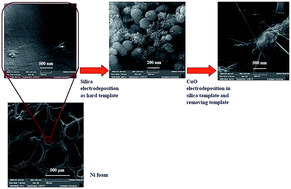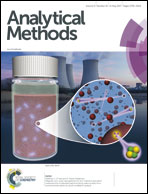Templated electrodeposition of vertically aligned copper oxide nanowire arrays on 3D Ni foam substrates for determination of glucosamine in pharmaceutical caplet samples†
Abstract
A copper oxide nanowire network electrode has been fabricated through an electrodeposition procedure using mesoporous silica film as the template on Ni foam. The metal oxide nanostructures on Ni foam as a three dimensional electrode provide a very high surface area to the electrode built on a low cost material. These electrode features were considered with X-ray diffraction (XRD), electrochemical impedance spectroscopy (EIS) and field emission scanning electron microscopy (FE-SEM). The electrochemical properties of the electrodes have also been studied. The prepared electrode was applied as a glucosamine sensor. The presented sensor possesses a high electrochemically active surface area and demonstrates high current density for glucosamine electro-oxidation. The presented sensor has a wide dynamic range of four orders of magnitude to glucosamine in two linear ranges from 1.45 μM to 0.32 mM and 0.32 mM to 36.4 mM, with a high sensitivity of 9.23 mA mM−1 cm−2 in the first range and 1.85 mA mM−1 cm−2 in the second range and a low practical detection limit of 0.32 μM. It also showed outstanding long-term stability, good reproducibility and accurate measurement in the pharmaceutical sample.


 Please wait while we load your content...
Please wait while we load your content...